Arisarum proboscideum
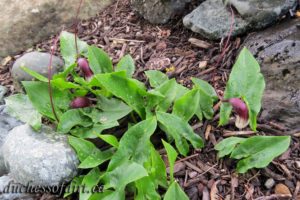 Arisarumproboscideum Family: Araceae
Arisarumproboscideum Family: Araceae
(ay-ri-SAR-um pro-bos-SID-ee-um)
Common name: mouse plant; mouse tail plant
Zone: USDA 7 – 9
Height: 4 – 6 in (10-15 cm)
Spread: 18 in (45 cm)
Aspect: part to full shade
Soil: humus-rich; moist; well-drained
Water: moderate; drought tolerant
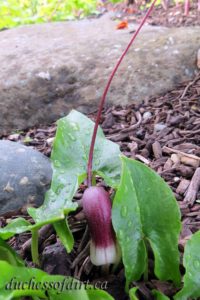 Description: An herbaceous, tuberous-rooted, ground-hugging woodland perennial with glossy green, arrowhead-shaped leaves. Flowers are maroon and white with a unique tail-like tip which can stretch to 6 inches (15 cm). The whole floral effect is of the back end of a mouse diving underground with its tail waving in the air.
Description: An herbaceous, tuberous-rooted, ground-hugging woodland perennial with glossy green, arrowhead-shaped leaves. Flowers are maroon and white with a unique tail-like tip which can stretch to 6 inches (15 cm). The whole floral effect is of the back end of a mouse diving underground with its tail waving in the air.
Special Notes: Native to Spain and Italy, this plant is related to Arisaema triphyllum (jack-in-the-pulpit) which is native to eastern North America. It is winter hardy to USDA Zone 7…Zone 6 if given some protection. This is a spring ephemeral, appearing in early spring and disappearing below ground in the heat of summer.
Flowers are complete… having both male and female sexual organs. Fertilization is accomplished when the flowers attract small fungus gnats which subsequently become trapped within the flower and, in their struggle to escape, they inadvertently spread pollen from the male organs to the female.
Relatively drought tolerant once established. Pest and disease resistant.
In our Zone 7a garden: First signs of emergence start in the first two weeks of spring with tiny green spires of furled leaves appearing. Flower stems and buds show up shortly after. Bloom time begins about the second week of April and lasts remarkably well through to about the end of June. As soon as the heat really begins to ramp up, the whole clump disappears until the following spring.
I should mention…my one clump of mouse plant is situated in almost complete shade. Sun only reaches it in late winter and early spring and number of duration days only extends until the surrounding herbaceous perennials appear and leaf out and the chestnut tree leaves reach out to full canopy limit.
Great Plant Pick (GPP) 2008
Posted on April 2, 2020; updated on August 6, 2024
Aquilegia vulgaris ‘Woodside Gold’
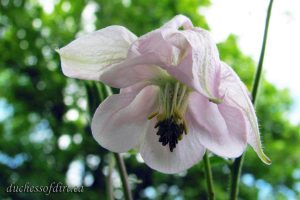 Aquilegia vulgaris ‘Woodside Gold’
Aquilegia vulgaris ‘Woodside Gold’
(a-kwi-LEE-jah vul-GAR-is)
syn. Aquilegia vulgaris ‘Woodside Golden’; Aquilegia vulgaris Woodside Strain
Family: Ranunculaceae
Common name: columbine; granny’s bonnet; European crowfoot
Zone: 3 – 8
Height: 2 – 3 ft (60 – 90 cm)
Spread: 1 – 1.5 ft (30 – 45 cm)
Aspect: sun; partial shade
Soil: average; humus-rich
Water: moderate
Description: An herbaceous, small clump-forming perennial with thin, branching stems adorned with golden scalloped leaves. Somewhat upward-facing, short-spurred, soft pink flowers appear in early April through into late May or early June. Attracts bees and hummingbirds.
Special Notes: Native to Europe, Aquilegia vulgaris has been grown in gardens for centuries. Over the years, the plant has escaped its garden boundaries and become naturalized, both in its native region and in North America.
Given optimum growing conditions and regular water, the plant will develop a lovely clump. It readily self-seeds which ensures this purported short-lived perennial will enjoy many years in the garden. Easy care.
Drought tolerant once established. Attracts bees and hummingbirds. Deer and rabbit resistant, however slugs and aphids may be a problem. Leaves are susceptible to leaf miner.
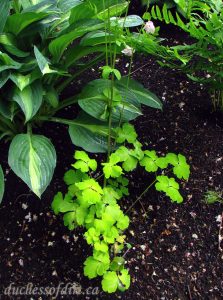 In our Zone 7a garden: I have a clump of ‘Woodside Gold’ in my island bed where it is mostly in shade and competes with big tree roots. The leaves hold their gold colour quite well, only slightly darkening to a green-gold colour as the season progresses. Being in the shade, the flowers on mine are a lovely soft pink colour.
In our Zone 7a garden: I have a clump of ‘Woodside Gold’ in my island bed where it is mostly in shade and competes with big tree roots. The leaves hold their gold colour quite well, only slightly darkening to a green-gold colour as the season progresses. Being in the shade, the flowers on mine are a lovely soft pink colour.
John has a clump in his back garden where it gets a fair amount of sun throughout the day. The leaves on this clump turn a green-gold colour quicker than those in my garden and the flowers are more of a dusky-rose colour. We both cut the leaves down to the ground as they get ratty-looking later in the season.
Posted on February 13, 2023; updated on August 6, 2024
Allium ‘Purple Sensation’
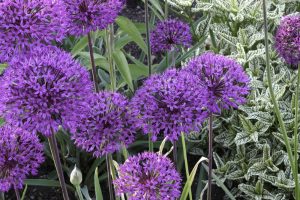 Allium ‘Purple Sensation’
Allium ‘Purple Sensation’
(AL-lee-um)
syn. Allium hollandicum ‘Purple Sensation’;
Allium aflatunense ‘Purple Sensation’
Family: Amaryllidaceae
Common name: ornamental onion
Zone: 4 – 10
Height: 28 – 32 in (70 – 80 cm)
Spread: 4 – 8 in (10 – 20 cm)
Aspect: sun; partial shade
Soil: average; humus-rich; well-draining
Water: moderate
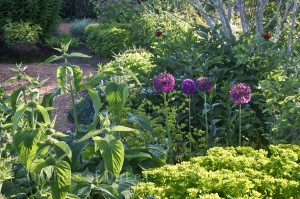 Description: A bulbous perennial with short basal leaves that die down by flowering time. Flower head consists of over 100 small, star-shaped purple-red blooms that form a globular starburst atop a sturdy green stem.
Description: A bulbous perennial with short basal leaves that die down by flowering time. Flower head consists of over 100 small, star-shaped purple-red blooms that form a globular starburst atop a sturdy green stem.
Special Notes: This allium looks great in a grouping of 7 – 9, or more. Recommend planting a low-lying perennial in front of the alliums to hide the less-than-stellar allium leaves. Flowers attract bees in good numbers. Deer and rabbit resistant. Can fall prey to the same diseases that afflict onions and garlic.
Caution: All parts are poisonous to humans in some degree.
Posted on February 12, 2023; updated on August 6, 2024
Anthriscus sylvestris ‘Ravenswing’
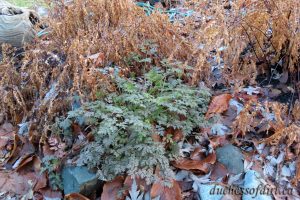 Anthriscus sylvestris ‘Ravenswing’
Anthriscus sylvestris ‘Ravenswing’
syn. Anthriscus ‘Ravenswing’
(an-THRIS-kus sil-VES-tris)
Family: Apiaceae
Common name: cow parsley, wild parsley, gypsy lace, Queen Anne’s lace, lady’s needlework
Zone: 5
Height: 3 – 4 ft (90 – 120 cm)
Spread: 1 – 2 ft (30 – 45 cm)
Aspect: full sun to partial shade
Soil: average; well-draining
Water: regular, moderate
Description: An herbaceous, upright, delicate-looking perennial. Attractive, deeply incised, rosy-purple leaves make a frothy appearance in late winter or early spring atop thin purple stems. Airy cymes of white flowers add to the delicacy of this plant in late spring through mid-summer.
Special Notes: Native across Europe, northwest Africa, western Russia and Asia. Preference is for sunny to dappled shade locations; tolerant of poor soil conditions with moderate water. Drought tolerant once established. Cymes of white flowers attract pollinators and look good as cut flowers. Resistant to rabbits; not sure about deer. Slugs and snails may be a problem for young plants. Powdery mildew may be a problem in summer if in a crowded area with inadequate breeze.
Self-seeds so best to deadhead spent flowers before seeds drops. However, young seedlings are easily pulled in the spring before their tap root has developed. Removing older plants means digging down to get all of the root.
If you collect seed from this plant, it will need some vernalization (a cold period) in order to kick start germination. I find it much easier to let some seeds overwinter in place in the garden to sprout in the spring.
In our Zone 7a garden: This is one of my favourite plants for ease of care and bullet-tough constitution. Fresh foliage appears in late January, early February and handles surprise frosts well. An Australian nursery claims ‘Ravenswing’ is frost hardy to -10 °C (14 °F) and I believe it. There is never any frost damage on the early new growth after a late frost.
All of our ‘Ravenswing’ have come from a single plant on which I occasionally let a few flowers go to seed. I have not experienced any problems with slugs or snails or rabbits. We are fenced for deer but one got in recently but either did not find my newly emerging ‘Ravenswing’ plants or chose not to taste them.
Posted on February 8, 2024; updated on August 6, 2024
Alchemilla mollis
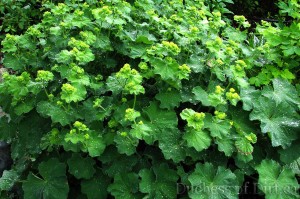 Alchemilla mollis Family: Rosaceae
Alchemilla mollis Family: Rosaceae
(al-kem-ILL-ah MAWL-iss)
syn. Alchemilla vulgaris
Common name: lady’s mantle
Zone: 3 – 8
Height: 18 – 24 in (45 – 60 cm)
Spread:18 – 24 in (45 – 60 cm)
Aspect: full sun; partial shade
Soil: average
Water: moderate
Description: An herbaceous perennial with good ground-covering foliage that forms a neat mound. Soft, pale grey-green rounded leaves are lobed and have crinkled edges. Airy sprays of tiny greenish-yellow flowers from spring to mid-summer.
Special Notes: Native to Greece, Turkey and Caucasus. The 2 – 4 inch (5 – 10 cm) leaves hold small droplets of water and dew. Good cut flower; dries well for floral arranging. Prolific self-seeder. Cut entire plant back to ground when flowers are spent and before they set seed. Relatively pest and disease free. May get powdery mildew in hot humid climate. Drought tolerant. Propagation by seed; division in spring or autumn.
RHS Award of Garden Merit 1993
Posted on December 17, 2012; updated on August 6, 2024
